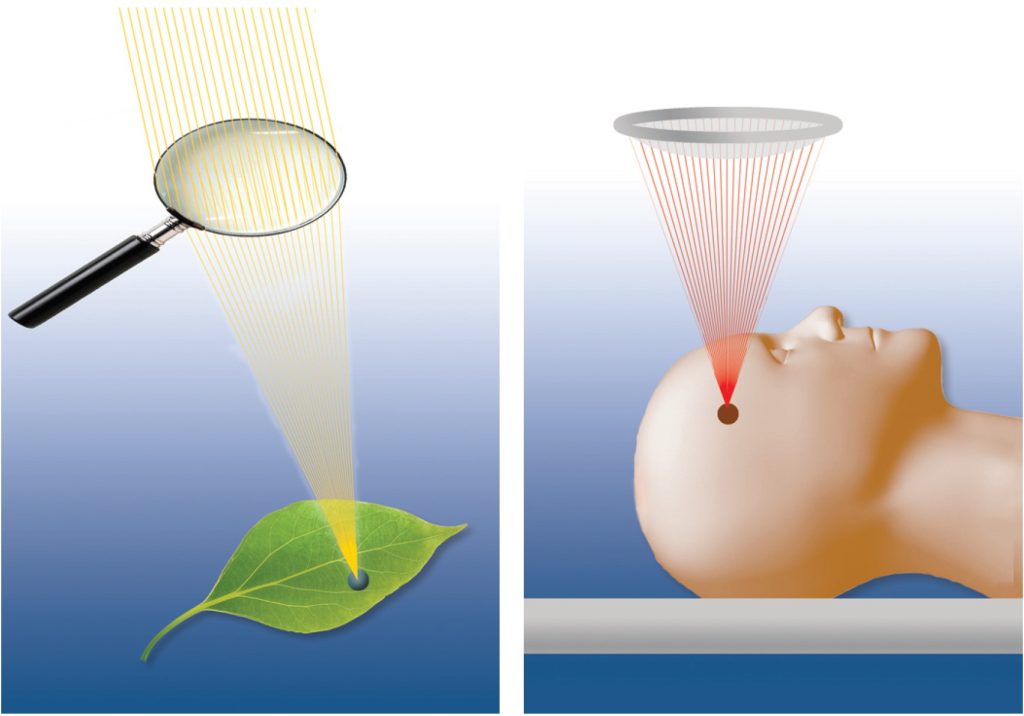Focused ultrasound (FUS) guided by magnetic resonance imaging (MRI) is an alternative to standard treatments for neurological, oncological, and musculoskeletal diseases. The technology allows targeted treatments over a wide range of FUS intensities that induce mechanical, thermal, and neuroelectric effects on tissues while preserving surrounding organs.1 Globally, FUS has been approved for treatment for over 30 indications. In the United States, usage is approved for bone metastases, osteoid osteoma, tremors and dyskinesia in Parkinson’s disease, prostate cancer, benign prostatic hyperplasia, and uterine fibroids.2
The technology
“FUS is analogous to using a magnifying glass to focus beams of light on a point to burn a hole in a leaf but, instead of an optical lens, an acoustic lens is used to focus multiple beams of ultrasound energy to target deep in the body with a high degree of precision and accuracy, sparing the adjacent normal tissue,” said Neal Kassell, MD, founder and chairman of the Focused Ultrasound Foundation. “Each of the individual beams only has the power of diagnostic ultrasound until the focal convergence point.”

The application of MR-guidance in thermal ablations through high-intensity focused ultrasound (HIFU) continues to be the subject of numerous studies and clinical trials.1 Though potential clinical applications of HIFU were reported as early as the 1950s, precise targeting was a major issue. Finally, in 2004, the first MRI-guided HIFU application received FDA approval for the removal of uterine fibroids.3
Ultrasound enables deep tissue treatment, improves focus on the target tissue through its small wavelengths, and offers precise control over the shape and location of energy deposition. It is noninvasive, extracorporeal, and nonionizing as compared to conventional cancer treatment methods like chemotherapy, radiotherapy, and open surgery.4
At the other end of the acoustic spectrum, low-intensity FUS (LIFU) is frequently used for locally and reversibly eliciting excitatory and inhibitory neuromodulation or to facilitate drug and gene delivery through the permeabilization of the blood-brain barrier.1
“Currently, we know 25 different ways that FUS affects tissue at the focal point. A decade ago, we understood three,” said Kassell. ”This creates the opportunity to treat a large variety of disorders as compared to radiation therapy or a surgical robot.
“FUS can be used to destroy tissue and to deliver therapeutic agents to the point in the body where they are needed, minimizing systematic side effects and thereby enhancing treatment effectiveness and safety. “The effect is immediate and verifiable.”
Therapeutic potential
Today, worldwide, treatments for nearly 170 clinical indications are in various stages of R&D and commercialization, up from three a decade ago, according to Kassell. “We just began getting coverage and reimbursement from government and commercial organizations,” he said. “One of our challenges is to not have FUS as one of medicine’s best-kept secrets. FUS is the most powerful sound you will never hear but it is the sound that can one day save your life.”
FUS use continues to grow. The applications that excite Kassell most are for brain indications like Alzheimer’s, Parkinson’s, ALS, Huntington, OCD, depression and other neuropsychiatric disorders5, dystonia, epilepsy6, brain tumors, stroke, as well as for oncological indications and immunotherapy.
In a defined area, FUS can reversibly open the blood-brain barrier to allow access of therapeutic agents. Microbubbles, hollow lipid spheres approximately a tenth of the diameter of a red blood cell, can be packaged with therapeutics and millions injected intravenously. They burst and release the pharmacological payload at the FUS convergence point. The great promise of FUS combined with circulating microbubbles is reflected by a rapidly growing number of clinical trials to treat various brain diseases.7,8
“FUS is disruptive to physicians’ practices, referral patterns, and manufacturers of displaceable legacy therapeutic equipment. The evolution of any highly disruptive technology from idea to widespread utilization as a global standard-of-care is a glacial process. Every month that goes by that this amazing technology is not available results in unnecessary death, disability, and suffering for countless people,” said Kassell.
References
- Kamimura HAS, Conti A, Toschi N, Konofagou EE. Ultrasound neuromodulation: mechanisms and the potential of multimodal stimulation for neuronal function assessment. Front Phys. 2020; 8:150.
- Focused Ultrasound Foundation, 2022 State of the Field.
- Shehata Elhelf IA, Albahar H, Shah U, Oto A, Cressman E and Almekkawy M. High intensity focused ultrasound: The fundamentals, clinical applications and research trends. Diagnostic and Interventional Imaging 2018 99, 349—359.
- Izadifar Z, Izadifar Z, Chapman D and Babyn P. An Introduction to High Intensity Focused Ultrasound: Systematic Review on Principles, Devices, and Clinical Applications. Clin. Med. 2020, 9, 460; doi:10.3390/jcm9020460
- Wang JB, Di Ianni T, Vyas DB, Huang Z, Park S, Hosseini-Nassab N, Aryal M and Airan RD. Focused Ultrasound for Noninvasive, Focal Pharmacologic Neurointervention. Neurosci. 2020 14:675.
- Lescrauwaet E, Vonck K, Sprengers M, Raedt R, Klooster D, Carrette E and Boon P. Recent Advances in the Use of Focused Ultrasound as a Treatment for Epilepsy. Neurosci. 2022 16:886584.
- Chen S, Nazeri A, Baek H, Ye D, Yang Y, Yuan J, Rubin JB and Chen H. A review of bioeffects induced by focused ultrasound combined with microbubbles on the neurovascular unit. Journal of Cerebral Blood Flow & Metabolism 2022, Vol. 42(1) 3–26. DOI: 10.1177/0271678X211046129
- Wu SK, Tsai CL, Huang Y and Hynynen Focused Ultrasound and Microbubbles-Mediated Drug Delivery to Brain Tumor. Pharmaceutics 2021, 13, 15
Focused Ultrasound: Medicine's Best Kept Secret? - Genetic Engineering & Biotechnology News
Read More

No comments:
Post a Comment